Difference between revisions of "November 14, 2012"
| Line 1: | Line 1: | ||
__NOTOC__ | __NOTOC__ | ||
=A Long Cool One= | =A Long Cool One= | ||
| − | |||
<!-- ws:start:WikiTextHeadingRule:0:<h1> --> | <!-- ws:start:WikiTextHeadingRule:0:<h1> --> | ||
<!-- ws:start:WikiTextLocalImageRule:6:<img src="/file/view/LPOD-Nov14-12.jpg/382125096/LPOD-Nov14-12.jpg" alt="" title="" /> -->[[File:LPOD-Nov14-12.jpg|LPOD-Nov14-12.jpg]]<!-- ws:end:WikiTextLocalImageRule:6 --><br /> | <!-- ws:start:WikiTextLocalImageRule:6:<img src="/file/view/LPOD-Nov14-12.jpg/382125096/LPOD-Nov14-12.jpg" alt="" title="" /> -->[[File:LPOD-Nov14-12.jpg|LPOD-Nov14-12.jpg]]<!-- ws:end:WikiTextLocalImageRule:6 --><br /> | ||
| − | <em>south up drawing by [mailto:philip.morgan@talktalk.net Philip Morgan], U.K.</em><br /> | + | <em>south up drawing by [mailto:philip.morgan@talktalk.net" rel="nofollow Philip Morgan], U.K.</em><br /> |
<br /> | <br /> | ||
If you should ask me what was my favourite of all lunar views, I would have to say every time, the Mons Piton at sunset casting its tapering, 80klm long shadow eastwards towards the outer western ramparts of Cassini. Piton itself is an isolated peak in the Mare Imbrium; it has a summit depression, and attains a height in excess of 2200 m, with a basal measurement of 25 km. It has long been associated with mysterious changes in appearance throughout the lunar day. These were first noted by Gruithuisen and were confirmed by Pickering who ascribed them to deposits of hoar frost.<br /> | If you should ask me what was my favourite of all lunar views, I would have to say every time, the Mons Piton at sunset casting its tapering, 80klm long shadow eastwards towards the outer western ramparts of Cassini. Piton itself is an isolated peak in the Mare Imbrium; it has a summit depression, and attains a height in excess of 2200 m, with a basal measurement of 25 km. It has long been associated with mysterious changes in appearance throughout the lunar day. These were first noted by Gruithuisen and were confirmed by Pickering who ascribed them to deposits of hoar frost.<br /> | ||
<br /> | <br /> | ||
| − | <em>[mailto:philip.morgan@talktalk.net Philip Morgan]</em><br /> | + | <em>[mailto:philip.morgan@talktalk.net" rel="nofollow Philip Morgan]</em><br /> |
<br /> | <br /> | ||
Note by CAW: Reported changes at Piton are definetly not due to hoar frost, vegetation or any other discredited speculation of 100 years ago. But even if there are no changes other than due to lighting, Piton and its shadow are always fascinating to observe.<br /> | Note by CAW: Reported changes at Piton are definetly not due to hoar frost, vegetation or any other discredited speculation of 100 years ago. But even if there are no changes other than due to lighting, Piton and its shadow are always fascinating to observe.<br /> | ||
Revision as of 22:38, 4 January 2015
A Long Cool One

south up drawing by " rel="nofollow Philip Morgan, U.K.
If you should ask me what was my favourite of all lunar views, I would have to say every time, the Mons Piton at sunset casting its tapering, 80klm long shadow eastwards towards the outer western ramparts of Cassini. Piton itself is an isolated peak in the Mare Imbrium; it has a summit depression, and attains a height in excess of 2200 m, with a basal measurement of 25 km. It has long been associated with mysterious changes in appearance throughout the lunar day. These were first noted by Gruithuisen and were confirmed by Pickering who ascribed them to deposits of hoar frost.
" rel="nofollow Philip Morgan
Note by CAW: Reported changes at Piton are definetly not due to hoar frost, vegetation or any other discredited speculation of 100 years ago. But even if there are no changes other than due to lighting, Piton and its shadow are always fascinating to observe.
Technical Details
November 6, 2012, 04:00-04:50 UT. 305 mm Newtonian @ 400X.
Related Links
Rükl plate 12



